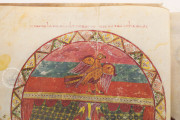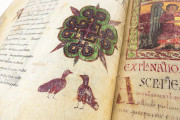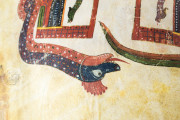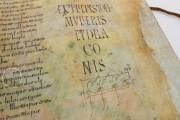The Morgan Codex is the earliest complete surviving manuscript in a centuries-long tradition of the production of lavishly illuminated manuscripts of Beatus of Liébana's commentary on the Apocalypse. Saint John the Divine's vision of the events leading to the end of time forms the final book of the Christian Bible, and its series of apparitions of fantastic beasts and scenes of terrestrial destruction inspired vivid paintings, especially on the Iberian Peninsula. Created around 940-945 in northwestern Spain, the Morgan Beatus is embellished with eighty-nine figural scenes, mostly framed miniatures; eleven pages of illustrated genealogical tables; and additional painted embellishment.
The manuscript's principal illuminator, Maius, employed a bright palette dominated by primary colors, the blue being particularly intense and often mixed with red to make purple. His trademark is drapery painted in multiple contrasting colors. Gold and silver are employed only in the early pages.
Elaborate Pictorial Introduction
Most of the paintings illustrate the Apocalypse, but the manuscript is the earliest witness to an expanded program of illumination that will be followed in many later copies of the text: a series of portraits of the authors of the Gospels and angels (fols. 1v-4r), an illustrated genealogy of Christ (fols. 4v-9v), and a series of scenes illustrating the prophecy of Daniel (fols. 238v-276v).
Beasts Terrible to Contemplate
Among the creatures described by Saint John and vividly portrayed by Maius in the Morgan Codex are locusts, a seven-headed dragon, and yet another seven-headed beast. The locusts, described in the Apocalypse as having the power of scorpions, appear very scorpion-like as they issue from a pit (fol. 140v). In a later scene, they appear as quadrupeds with long tails (fol. 142v), inspired by John's text, which describes them as having features of horses, lions, and scorpions.
Fear of the Judgment at the Second Coming
The Morgan Codex is remarkable for including a statement by its principal painter, Maius, about the purpose of the illustrative program. He states that he supplied pictures for the "wonderful words" of John's vision "so that the wise may fear the coming of the future judgment of the world's end" (fol. 293r).
Maius, Painter and Scribe
Not only did Maius illuminate the Morgan Codex, but he also wrote most of its Latin text. It is thought that a second scribe was responsible for a small portion of the text and that a second painter assisted toward the end of the book, but Maius's undertaking here was enormous. We know him also to have contributed to the illumination of the Tábara Codex. In that manuscript, he identifies himself as a monk and priest.
Made at the Command of an Abbot
Maius reports in the colophon that the Morgan Codex was created at the behest of an abbot (who can be identified as an abbot of San Miguel de Moreruela) "out of love for the book of the vision of John the beloved disciple," a reference to Saint John the Evangelist who was believed in the Middle Ages to have been the author of the Apocalypse. The manuscript was not made at Moreruela, though, but at San Salvador de Tábara, about 24 kilometers west of Moreruela.
A Series of Distinguished Collections
The Morgan Codex was bequeathed to the Orden de Santiago de Uclés by Martín Pérez de Ayala (1504-1566), Archbishop of Valencia. It was owned in the nineteenth century by the German antiquarian and bibliophile Roberto Frassinelli (1811-1887) and then by Bertram Ashburnham (1797-1878), Earl of Ashburnham. Henry Yates Thompson (1838-1928) acquired the manuscript in 1897, and then J. P. Morgan (1867-1943) in 1919. In 1993 the manuscript was bound in two volumes (fols. 1-149 and fols. 150-300).
_____
For more information on the Beatus model, read our blog article by Amy R. Miller (PhD, Medieval Art History, University of Toronto).
We have 3 facsimiles of the manuscript "Beatus of Liébana - Morgan Codex":
- El Beato de San Miguel de Escalada facsimile edition published by Editorial Casariego, 1991
- Beatus-Apokalypse der Pierpont Morgan Library facsimile edition published by Belser Verlag, 1991
- Apocalipsis de San Juan. Beato de Liebana. San Miguel de Escalada facsimile edition published by Scriptorium, 2001

















































